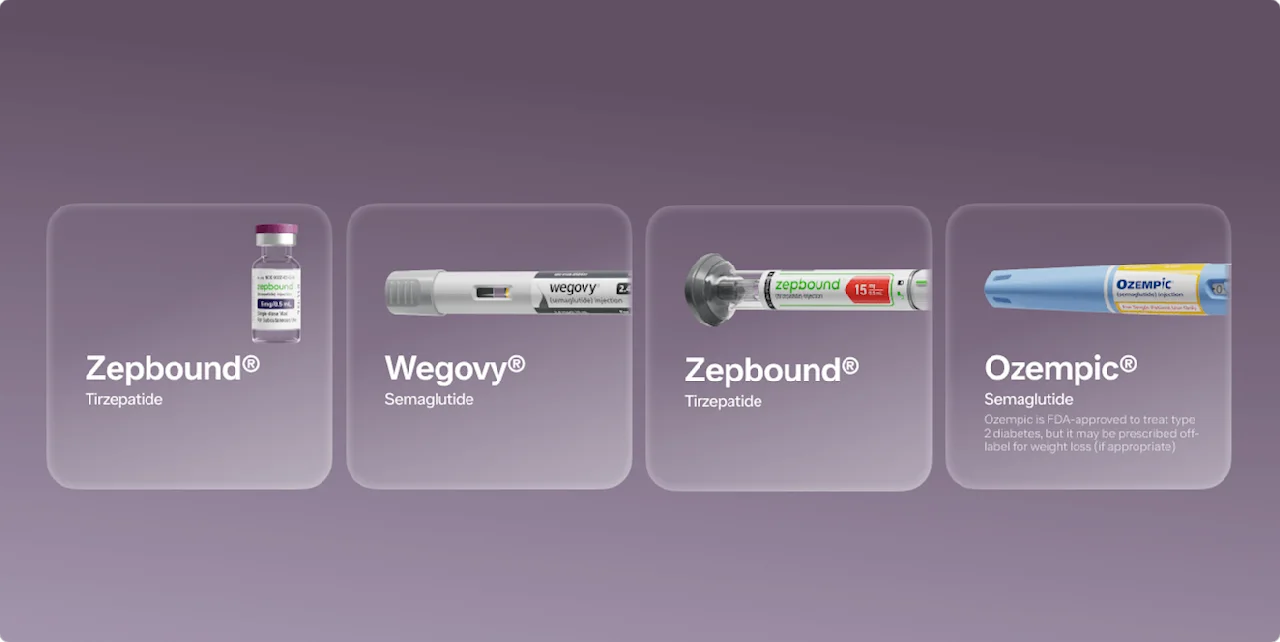Here's what we'll cover
Here's what we'll cover
Ozempic (semaglutide) is an FDA-approved injectable medication that, in combination with diet and exercise, helps people with type 2 diabetes control their blood sugar levels. The drug also reduces the risk of a serious cardiovascular event, such as heart attack or stroke, in people with type 2 diabetes and heart disease.
Like most drugs, Ozempic may cause interactions with other medications or substances like alcohol. Mainly, combining Ozempic with other glycemic-lowering medications, such as insulin or sulfonylureas, may lead to hypoglycemia (low blood sugar). Because Ozempic slows down digestion, it may also affect how quickly your body absorbs other medications you take orally.
Below we review the most common Ozempic interactions you should know about before taking Ozempic.
1. Insulin
Among people who take both Ozempic and insulin, Ozempic may raise the risk of experiencing low blood sugar. Your healthcare provider may adjust your dosage of insulin or Ozempic in order to prevent this side effect.
Insulin is a hormone that regulates blood sugar levels. In people with type 2 diabetes, the body does not release insulin when needed, or at all, resulting in high blood sugar levels.
Ozempic and insulin are two medications that can help people with type 2 diabetes regulate blood sugar levels. Ozempic works by mimicking an incretin hormone called glucagon-like peptide-1, which tells the pancreas to release insulin when glucagon levels get too high after eating. Insulin helps the body better use and convert glucose into energy, so it doesn’t build up in the bloodstream. Hypoglycemia is a potential side effect of insulin as well.
While Ozempic doesn’t usually cause hypoglycemia on its own, because both Ozempic and insulin work to lower blood sugar, when the two medications are used simultaneously, hypoglycemia can occur. Your healthcare provider may adjust the dosage of either medication to prevent this from happening, and will want to monitor your blood sugar levels during treatment.
2. Sulfonylureas
Sulfonylureas are oral diabetes medications that help control blood sugar levels, either when taken alone or with other medications, such as metformin. They are insulin secretagogues, which is a fancy way of saying that these medications encourage the pancreas to release (or secrete) insulin. Examples of sulfonylureas include glibenclamide (Glynase), glipizide (Glucotrol, Glucotrol XL), and glimepiride (Amaryl).
Like insulin, sulfonylureas work by telling the pancreas to release more insulin. But while Ozempic specifically makes the pancreas release more insulin in response to food and blood sugar spikes, sulfonylureas encourage insulin production regardless of your current blood glucose levels. As a result, people who take both Ozempic and sulfonylureas may be more likely to experience hypoglycemia, or low blood sugar. To lower the potential risk, healthcare providers may adjust the dosage of Ozempic or sulfonylurea.
3. Glinides
Glinides are another type of insulin secretagogue, similar to sulfonylureas. Examples of glinides include repaglinide (Prandin) and nateglinide (Starlix). Given their effect on insulin production, taking glinides and Ozempic at the same time may increase the risk of experiencing hypoglycemia.
To lower this risk, your healthcare provider will likely adjust the dosage of glinide or Ozempic. If you take insulin or an insulin secretagogue like glinide or sulfonylureas, tell your healthcare provider before starting Ozempic. Ask for their advice on recognizing the signs of low blood sugar and managing your blood sugar levels.
4. Oral medications and supplements
In addition to encouraging insulin release, Ozempic also slows gastric emptying, so it takes longer for your stomach to empty fully. This helps prevent blood sugar spikes, but it can also slow the rate at which other oral medications get absorbed by your body—simply because they’re staying in your stomach longer. In clinical trials, this delay was not significant enough to be considered “clinically relevant.”
Still, it’s important to tell your healthcare provider before starting Ozempic about any medications you take orally, including any prescription drugs or over-the-counter medications, supplements, herbs, or vitamins. They may have recommendations for how to adjust your dosage to avoid any adverse effects.
5. Alcohol
Currently, no studies have looked into the effects of mixing alcohol with Ozempic. To be safe, you may want to limit or avoid drinking alcohol while taking Ozempic to prevent any interactions. Alcohol and Ozempic can both lower blood sugar, so taking them together could increase the risk of hypoglycemia — particularly for people with type 2 diabetes who are also taking insulin.
Health experts recommend that people with type 2 diabetes limit their alcohol to one drink or less per day for women, and two drinks or less per day for men.
6. Foods
Currently, no foods are known to interact with Ozempic. However, fried or greasy foods may exacerbate some of the side effects of Ozempic, or create similar symptoms like nausea, heartburn, bloating, or gas.
If you experience nausea while taking Ozempic, Novo Nordisk, the manufacturer of Ozempic, recommends the following:
Eat bland, low-fat foods like crackers and rice
Eat foods that have a lot of water, like soup
Eat more slowly
Drink ice-cold water
Avoid lying down after eating
Go outside for fresh air
Who should avoid Ozempic?
Certain medical conditions and risk factors may increase your risk of experiencing interactions with Ozempic, such as an allergy to Ozempic or the ingredients in Ozempic. Before starting Ozmpic, fill your healthcare provider in on your personal and family medical history, including any medical conditions you have and any drugs or supplements you are taking.
People with Multiple Endocrine Neoplasia syndrome type 2 or those with a personal or family history of medullary thyroid carcinoma should not use Ozempic. In animal studies, semaglutide — the active ingredient in Ozempic — was shown to cause thyroid C-cell tumors in rats. While it is not known if semaglutide has the same effect in humans, people with these thyroid conditions should not use Ozempic.
Additionally, people with the following medical conditions may be more likely to experience interactions or complications when using Ozempic:
Pancreatitis
Diabetic retinopathy
Kidney problems
Gallbladder problems
People who are pregnant or breastfeeding should avoid using Ozempic. If possible, stop using Ozempic at least two months before you get pregnant.
Before starting Ozempic, tell your healthcare provider if you or anyone in your family have any of the above conditions. This will help them determine if Ozempic is safe for you to use, or if another GLP-1 medication would be a better option.
How to avoid Ozempic interactions
To avoid interactions with Ozempic, talk with your healthcare provider beforehand. Tell them about any medical conditions that you currently have or that run in your family, and share a complete list of any prescription and over-the-counter drugs you are taking. Include any vitamins, supplements, or herbs, too.
Once you’ve been prescribed Ozempic, take the medication as prescribed. Follow your healthcare provider’s dosage recommendation. The medication will come with instructions and additional information on injecting Ozempic, storing the medication (in your refrigerator), and potential interactions. Read through all this paperwork and contact your healthcare provider if you have any questions.
This article reviews the main Ozempic interactions known at this time, and it may not be an exhaustive list. Generally, people taking insulin or insulin secretagogues like sulfonylureas or glinides may be at increased risk of experiencing hypoglycemia when taking Ozempic. Ozempic may slow the absorption of other orally administered medications. Finally, while no foods have been known to cause interactions with Ozempic, people with type 2 diabetes may want to limit their consumption of alcohol and greasy, fried, or sugary foods to avoid experiencing nausea or other gastrointestinal symptoms.
Talk to your healthcare provider if you have any concerns about experiencing interactions while taking Ozempic.
DISCLAIMER
If you have any medical questions or concerns, please talk to your healthcare provider. The articles on Health Guide are underpinned by peer-reviewed research and information drawn from medical societies and governmental agencies. However, they are not a substitute for professional medical advice, diagnosis, or treatment.
Chen, M., Hu, C., & Jia, W. (2015). Pharmacogenomics of glinides. Pharmacogenomics, 16(1), 45–60. doi:10.2217/pgs.14.152. Retrieved from https://pubmed.ncbi.nlm.nih.gov/25560470/
Collins, L. & Costello, R. A. (2023). Glucagon-like Peptide-1 Receptor Agonists. StatPearls. Retrieved from https://www.ncbi.nlm.nih.gov/books/NBK551568/
Costello, R. A., Nicolas, S., & Shivkumar, A. (2023). Sulfonylureas. StatPearls. Retrieved from https://www.ncbi.nlm.nih.gov/books/NBK513225/
Evert, A. B., Dennison, M., Gardner, C. D., et al. (2019). Nutrition Therapy for Adults With Diabetes or Prediabetes: A Consensus Report. Diabetes Care, 42(5), 731–754. doi:10.2337/dci19-0014. Retrieved from https://pubmed.ncbi.nlm.nih.gov/31000505/
MedlinePlus. (2022). When you have nausea and vomiting. Retrieved from https://medlineplus.gov/ency/patientinstructions/000122.htm
Novo Nordisk. (2022). Frequently asked questions/Ozempic® (semaglutide) injection 0.5 mg or 1 mg. Retrieved from https://www.ozempic.com/faqs.html
Phillips, A. & Clements, J. N. (2022). Clinical review of subcutaneous semaglutide for obesity. Journal of Clinical Pharmacy and Therapeutics, 47(2), 184–193. doi:10.1111/jcpt.13574. Retrieved from https://pubmed.ncbi.nlm.nih.gov/34964141/
Rahman, M. S., Hossain, K. S., Das, S., et al. (2021). Role of Insulin in Health and Disease: An Update. International Journal of Molecular Sciences, 22(12), 6403. doi:10.3390/ijms22126403. Retrieved from https://pubmed.ncbi.nlm.nih.gov/34203830/
Smits, M. M. & Van Raalte, D. H. (2021). Safety of Semaglutide. Frontiers in Endocrinology, 12, 645563. doi:10.3389/fendo.2021.645563. Retrieved from https://pubmed.ncbi.nlm.nih.gov/34305810/
Thota, S, & Akbar, A. (2022). Insulin. StatPearls. Retrieved from https://www.ncbi.nlm.nih.gov/books/NBK560688/
U.S. Food and Drug Administration (FDA). (2020). Highlights of Prescribing Information: OZEMPIC (semaglutide) injection, for subcutaneous use. Retrieved from https://www.accessdata.fda.gov/drugsatfda_docs/label/2020/209637s003lbl.pdf











